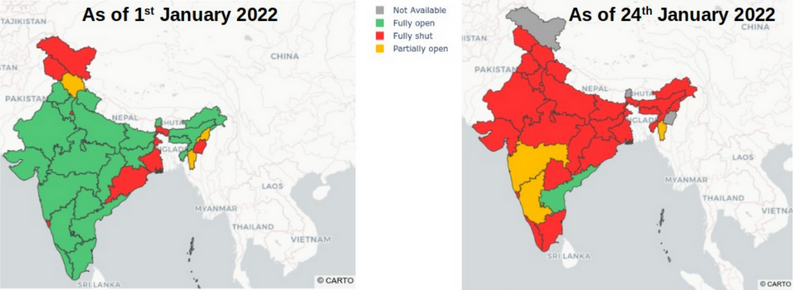 – Anusha Sharma, member of the National Coalition on the Education Emergency and a Program Assistant with IT for Change
– Anusha Sharma, member of the National Coalition on the Education Emergency and a Program Assistant with IT for Change
The tremendous impact of the Covid-19 pandemic on education has been felt world over and in India, it has further weakened an already fragile public education system, pushing our children to the brink. Prolonged school closures combined with caste, gender, and economic marginalisations posed catastrophic challenges for children – forcing them to endure malnutrition, physical and mental health challenges, child labour, and early marriages, in addition to loss of structured learning opportunities and learning deprivation. With tens of millions of children of Dalits, Adivasis, the poor and the marginalized suffering disproportionately, this has been the biggest blow to social justice and equity since independence.
The right to education is a fundamental right of children, that must be upheld at all times and at all costs. However, the response of the political establishment to this education crisis has been mostly apathetic, with state and country wide lockdown imposition (consequently school closures) being the default response. Beyond teaching-learning, the school also serves as a space that provides opportunities for peer and teacher-student relationships to thrive, and specially for children from under-served families whose parents don’t have work-from-home possibilities, it provides an assurance of safety and a nutritious meal – all of which the student is deprived of by the shutting down of schools.
The impact of school closure on learning is widely variable across any given group of children. Parents and caretakers have expressed that young children have forgotten habits of learning including those of routine and hygiene; basic reading and numeracy skills have been gravely affected[1]. After a disruption of this nature, imagine a teacher returning to her classroom, to find children who have suffered losses in their families, who have had to work to financially support their families, who have shifted from English-medium private schools to government schools which would teach in the state language, who have had some support to engage in learning, who have forgotten most of what they had learnt, who have not had any learning progress, while also realizing that some have not returned to school at all. The teacher would need empathetic, regular, on-going support, to respond to the diversity of teaching-learning situations they will face in the classroom and not a one-off training or a short “bridge course”.
While department officials took steps to promote educational TV programs and there were efforts by schools and educators to provide online/remote education, the lack of access to essential digital infrastructure for over 80% of children[2] in the country prevented access to these learning opportunities as well. In a survey done to understand the learning experiences of students during the pandemic, learners expressed that TV programs were hardly beneficial. In the words of students, “they don’t give time to write, the screen changes very fast so we can’t make notes”, “When teacher is in front of us we can ask questions directly but in TV we cannot get doubts cleared”[3]. For the small percentage of children who were able to access online education, the pedagogy posed several challenges and was not meaningful. Teachers were unprepared and lacked the required skills, training and support to utilize ICT tools to deliver lessons effectively via online mode. Teachers and parents who were surveyed as part of different studies have opined that remote learning materials and pedagogy are far less effective than classroom teaching .
The repercussions of all these factors are being seen currently in the form of drop outs, lack of interest and engagement among students, students being unable to learn because of the gap in their learning levels and the grade level teaching in schools, but it will also have long term impacts that would affect higher education enrolment, employment, future earnings, intellectual capacities of future citizens and enabling meaningful participation in a democracy. These will severely limit and affect India’s possibilities in a globalized economy as well as in social transformation
Throughout the pandemic, while the health emergency has been apparent, the ”invisible” emergency in education has been largely unrecognised in public discourse. There have been efforts at the local level by various educators and NGOs to mitigate the impact but a common forum where larger discussions and debates concerning the education crisis could be had was recognised as necessary to bring awareness on the education emergency. Based on principles of equity, universal access, humane education, decentralised decision-making and public investment, the National Coalition on the Education Emergency (NCEE) was established by individuals and groups across India to collectively work towards addressing the education emergency. Recognising that concerted efforts are needed in this pursuit, three working groups on social mobilization, research and educational support were set up. Through these working groups, the coalition has been making efforts to build awareness and understanding of the education emergency, track policies and their implementation, bring to focus the children’s right to education as enshrined in the RTE, create social pressure to urge governments to take necessary actions, lend educational support to schools and communities and provide research and evidence based recommendations to relevant stakeholders for the educational recovery of children.
The initial efforts of the coalition focused on the idea of the emergency being understood and captured in the imagination of people so that appropriate responses could then be conceived. Several media campaigns, press conferences and meetings with officials were conducted, advocating for the reopening of schools and resumption of mid-day meal programs which would make a huge difference in the lives of lakhs of children. A policy tracker tool to keep tab of the school opening status across states and to provide a larger picture of situation in the country was also developed.

In the months following the decline of the second wave and more recently the third wave, schools began to reopen gradually, but evidence across states shows that most governments have not factored in the implications of the school closures on children at all; students have simply been moved up by two grades with the the regular syllabus teaching resumed. In their haste to return to “business as usual”, governments have announced short, ineffective ‘bridge courses’ which would only serve to pressurize teachers and students to ‘catch up’. The NCEE in its release ‘A Future At Stake’ discusses in detail the steps to be taken by each stakeholder in the education system – teachers, schools, BRPs, CRP, BEOs, etc. to ensure that the needs of the children are met and they get the education they deserve. The need of the hour is for children to return to a caring, safe and conducive learning environment where the focus is on strengthening their learning-to-learn abilities and re-establishing connections amongst students and between teachers and students. Integration of socio-emotional learning across subject areas, where children’s own experiences and contexts are used in learning activities, is necessary.
During the budget preparation period, NCEE focused on education finance, advocating for untied grants to be given to schools and a substantial increase in the budget allocations for education with a clear focus on the disadvantaged and marginalized. Under-funding in the education sector has been a serious concern for decades and continues to be the case even today. The ‘Policy Tracker : State Education Finance’ consists of three maps that provide information on education budgets and education financing by state Ministries of Education for 2020-21 and 2021-22.
In its continued effort, the coalition has been producing research studies that highlight the impacts of the pandemic on children and their education, conducting high frequency surveys, curating curricular resources (OERs) to support individuals and groups working with children, developing a policy tracking tool containing state-wise information on education indicators/parameters, interacting with governments to formulate programs, guidelines and policies, writing letters to officials and running media campaigns urging necessary action.
At this point, a collective and sustained effort organized over multiple years is necessary for the recovery and renewal of education. The coalition is trying to persuade state governments to come together to share experiences, learn from each other and formulate a common framework in a spirit of co-operative federalism, transcending party politics. It is being explored if state governments could take the lead in hosting national conferences on different aspects of the emergency, to share ideas, experiences and resources amongst themselves and to facilitate to become a mass movement of the people for emancipation and social justice. Going back to schooling as usual would be a devastating tragedy.























